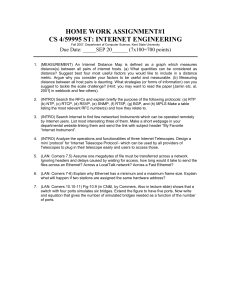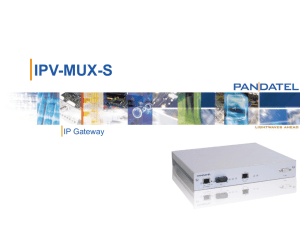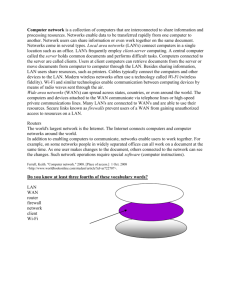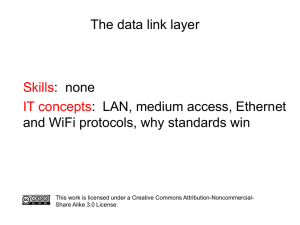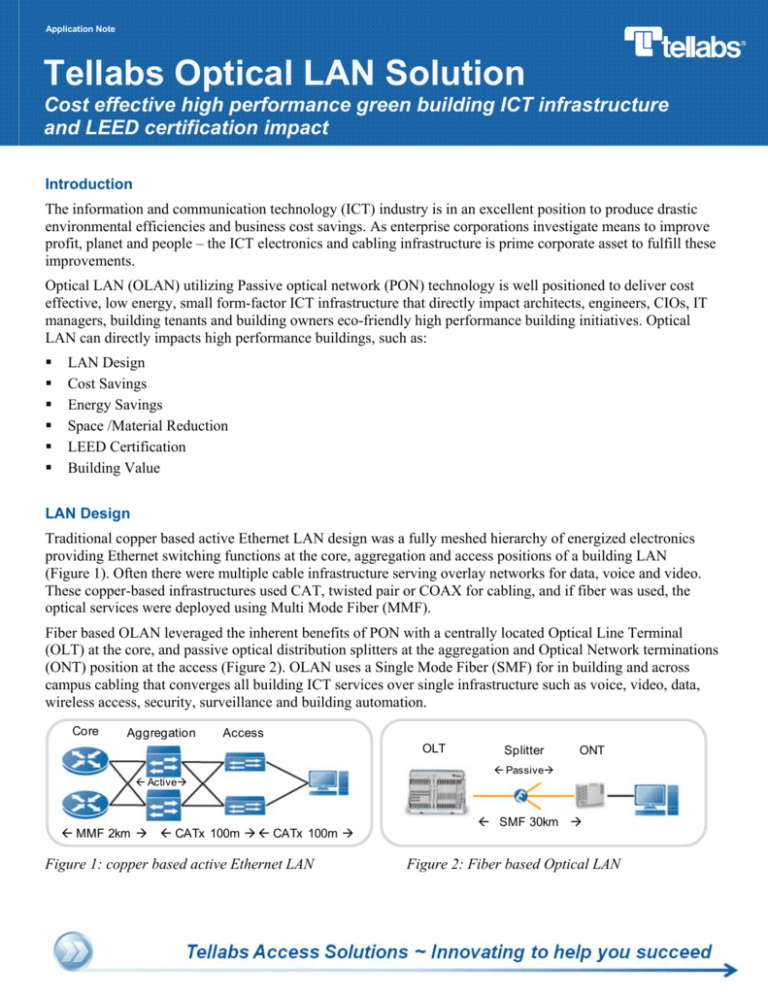
Application Note
Tellabs Optical LAN Solution
Cost effective high performance green building ICT infrastructure
and LEED certification impact
Introduction
The information and communication technology (ICT) industry is in an excellent position to produce drastic
environmental efficiencies and business cost savings. As enterprise corporations investigate means to improve
profit, planet and people – the ICT electronics and cabling infrastructure is prime corporate asset to fulfill these
improvements.
Optical LAN (OLAN) utilizing Passive optical network (PON) technology is well positioned to deliver cost
effective, low energy, small form-factor ICT infrastructure that directly impact architects, engineers, CIOs, IT
managers, building tenants and building owners eco-friendly high performance building initiatives. Optical
LAN can directly impacts high performance buildings, such as:
LAN Design
Cost Savings
Energy Savings
Space /Material Reduction
LEED Certification
Building Value
LAN Design
Traditional copper based active Ethernet LAN design was a fully meshed hierarchy of energized electronics
providing Ethernet switching functions at the core, aggregation and access positions of a building LAN
(Figure 1). Often there were multiple cable infrastructure serving overlay networks for data, voice and video.
These copper-based infrastructures used CAT, twisted pair or COAX for cabling, and if fiber was used, the
optical services were deployed using Multi Mode Fiber (MMF).
Fiber based OLAN leveraged the inherent benefits of PON with a centrally located Optical Line Terminal
(OLT) at the core, and passive optical distribution splitters at the aggregation and Optical Network terminations
(ONT) position at the access (Figure 2). OLAN uses a Single Mode Fiber (SMF) for in building and across
campus cabling that converges all building ICT services over single infrastructure such as voice, video, data,
wireless access, security, surveillance and building automation.
Core
Aggregation
Access
OLT
Splitter
ONT
Å PassiveÆ
Å ActiveÆ
Å MMF 2km Æ
Å CATx 100m Æ Å CATx 100m Æ
Figure 1: copper based active Ethernet LAN
Å SMF 30km Æ
Figure 2: Fiber based Optical LAN
Application Note
Studies have shown that fiber access for telecommunications service providers are proven less resource
depletion, greenhouse gas emissions, carbon footprint and toxins into the environment compared to the status
quo1. OLAN seeks to exploit these same factors, and apply them to high performance buildings.
Cost Savings
In a direct comparison, OLAN has achieved positive separation beyond traditional copper based active Ethernet
LAN design relative to equipment CapEx, OpEx and fiber based cable infrastructure.
Equipment CapEx savings – OLAN has enjoyed up to 70% CapEx savings when compared to the copper
based alternative. Not all configurations result it such a large division, but at the simplest level it is intuitive that
with less electronics in the network, customers have less equipment to purchase. Other factors that expand on
the benefits of OLAN are the fact that a single OLT, single ONT and single SMF ODN infrastructure achieves
99.999% reliability. For active Ethernet LAN to achieve 99.999% availability then the network design would
dictate fully meshed, fully redundant electronics at core, aggregation, access and even redundant optical NICs at
workstations2.
Another factor that drives separation in cost is OLAN’s efficient support for both VoIP phones and analog
POTS phones, and IP video and RF video. OLAN can provide cost effective hybrid network architectures that
serve analog POTS phones and RF video over the same SMF cable infrastructure with concurrent service
delivery (i.e. both VoIP & POTS phones, and IP & RF video simultaneously).
Equipment OpEx savings – Once again, less equipment to purchase means less electronics to maintain, but it
also means less reoccurring annual right-to-use and service support agreements to purchase. Often these yearly
support fees can be as much as 80% higher the comparable fee associated with Tellabs OLAN solution.
Centralized control through Element Management System, instead of accessing network elements locally
through the craft user interfaces is major contributor to lower OpEx. Instead of many IT support personnel
fanning out to manage nodes spread-out across the facility, OLAN emphasizes centralized management through
an intuitive graphical user interface. IT personnel with limited human resources and juggling constant time
constraints will benefit from this efficient means of provisioning, adds, moves, changes and administering
software upgrade. Unfortunately large organization lose ~3.6% annual revenue due to network downtime and
there is a direct correlation with human factor being the largest contributor responsible for 50% to 80%
outages3. Thus, there are benefits to prioritizing machine-to-machine and centralized management as much as
possible.
OLAN also offers the lower first training costs and no cost of annual training refresh certifications. OLAN
training is typically completed after one week of classroom time. At the end of this 5-day OLAN training,
student gain the knowledge they need to operate the OLAN OLT, ONT and EMS. Competitive active Ethernet
training programs (e.g. CCNx certification) require weeks of commitment and annual refresh work. The biggest
expense of these active Ethernet certification courses is not the cost of the class, but the travel expense and lost
hours away from their expected daily work duties.
1
Developing a generic approach for measuring FTTH solutions using Life Cycle Analysis methodology http://www.ftthcouncil.eu/documents/Reports/SUDEFIB_LifeCycleAnalysis_Report0308.pdf
2
Enterprise Campus 3.0 Architecture: Overview and Framework (Figure 17)
http://www.cisco.com/en/US/docs/solutions/Enterprise/Campus/campover.html#wp709052
3
Juniper Networks - What’s Behind Network Downtime? Infonetics Research study 2008
http://www-05.ibm.com/uk/juniper/pdf/200249.pdf
Application Note
Cabling CapEx savings – OLAN and SMF gain CapEx saving relative to traditional copper based active
Ethernet LAN based on lower material and installation costs.
Relative to material cost savings, a TE Connectivity study compared SMF ($0.089 per lineal foot) and CAT6
($0.35 per lineal foot) and MMF ($0.45 per lineal foot) showed a substantial savings for OLAN SMF4.
With today’s bend resistant fiber solutions trending toward ever-easier installations and pre-terminated solutions
provide rapid and cost effective installations, Corning concluded that in many cases fiber solutions are less
costly than copper for inside building LAN infrastructure5. By combining on-site SC/APC connector system
provides fast installation with no fusion splicing, bend resistant fiber, ornamental wall molding with adhesive
backing solution, 3M was able to cut installation costs in half for existing facilities LAN cable infrastructure
upgrades6.
Furthermore, SMF resistance to electromagnetic interference (EMI), radio frequency interference (RFI) and
crosstalk, significantly reduces the design and installation rules around power cables. Lighter and stronger SMF
uses J-hook installation instead of cable trays and conduit. All of the above-mentioned results in lower cable
infrastructure installation costs.
Energy Savings
Customer generated business case have shown that OLAN can save up to 80% less power consumption by OLT
and ONTs when compared to traditional copper based active Ethernet LAN7. With a fully meshed hierarchy of
active Ethernet switches, energy is consumed every time an Optical-to-Electrical conversions or Electrical-toOptical conversion occurs. Obviously a passive optical network has fewer Optical-to-Electrical conversions or
Electrical-to-Optical conversions and therefore it will consume less energy8.
When the energy savings of OLAN is reviewed one quickly realizes the rippling effect that the savings causes
relative to electrical (plug load) and thermal (HVAC) load design of the total building. For example, 1-watt of
electricity consumption saved in a data center results in 2.4x savings throughout the entire building. This is a
direct result from less DC-DC, AC-DC, power distribution, transformer, generator and battery back-up needed.
From a thermal stand-point, lower energy consumption of OLAN most importantly results in less HVAC
capacity required. Forward looking building design could even use temperature hardened OLT in data
center/telecom closet and thus eliminate the need for forced air conditioning and only use fresh air ventilation.
With all the great energy savings directly resulting from OLAN, it is easy to extrapolate the corresponding
reductions in carbon emissions. For example, a 2,000 end-point Optical LAN building saves 28 KWH, thus
converting KWH to CO2, that building saves 165 tons carbon emissions per year9.
4
TE “Optical LAN Solutions Capabilities Overview and Fast Facts“ http://www.adc.com/Attachment/1270741792520/109364AE.pdf
Corning - “Understanding Fiber Optics and Local Area Networks“
http://catalog2.corning.com/CorningCableSystems/media/Resource_Documents/additional_information_rl/LAN-737-EN.pdf
6
3M http://solutions.3m.com/wps/portal/3M/en_US/Telecom/Home/Products/Fiber/OnePass/?WT.mc_id=PA_CMD_BBP_May_OnePass
CS
“Total Package from 3M Cuts Fiber Installation Costs in half“
http://multimedia.3m.com/mws/mediawebserver?mwsId=SSSSSufSevTsZxtUoY_xmYtZevUqevTSevTSevTSeSSSSSS-&fn=Elauwit%20case%20study.pdf
7
per A New Network Paradigm: Cutting Cost, Space and Energy Use (June 2010) http://www.tellabs.com/resources/papers/tlab_olan-paradigm_wp.pdf
8
“Vision and Roadmap Workshop on Routing Telecom and Data Centers Toward Efficient Energy Use” (October 2008)
http://www1.eere.energy.gov/manufacturing/datacenters/pdfs/vision_and_roadmap.pdf
9
per Tellabs "Optical LAN network architecture helps operators meet tangible green goals" April 2012
http://www.tellabs.com/blog/index.cfm/2012/4/4/Optical-LAN-network-architecture-helps-operators-meets-tangible-green-goals
5
Application Note
Space/Material Reduction
For OLAN space and material savings have direct impact on the equipment, cabling and the building itself.
Equipment impact – OLAN provide superior density with 8,192 IP/Ethernet end-points being served by one
OLAN OLT occupying 9 rack units or 15 ¾ inches (Figure 3). In comparison, an active Ethernet node that
serves 2,016 IP/Ethernet end-points occupies 90 rack units or 157 ½ inches (Figure 4). Furthermore, ODN
splitters eliminate the need for active electronics used in the aggregation sector of this LAN, there for telecom
closets/IDF are eliminated. This directly results in less space, power and thermals demands in the main data
center/MDF. It also means less space, power, thermals and FEWER telecom closets/IDF required through-out
the building.
Traditional LAN
2,016 users
90 rack units
3 telco racks used
OLAN
8,192 users
9 rack units
Figure 3: Data center OLAN OLT size & density
Figure 4: Data center active Ethernet size & density
Another aspect of OLAN equipment (and SMF cable) space and material reduction is its’ ability to converge
services. This single network infrastructure can support voice (IP or POTS), data, video (IP or RF), wireless
access points, building security, surveillance and automation.
This translates into OLAN being an excellent choice for buildings that have restricted space. For example,
OLAN is ideal for building with challenging cable access, especially retro-fits projects and even historic
buildings preservation.
Cabling impact – SMF provides best future proof all-fiber LAN infrastructure choice. In contrast to MMF and
CATx cabling, SMF has enjoyed stable industry standard over recent years and holds the best promise for
supporting future technologies (e.g. 10GbE GPON, WDM PON, 40GbE, 100GbE). For example, in March of
2010 NTT demonstrated the ability to transport 69Tbps of data over a single 240 km long SMF.
CATx cabling standard has not been stable with over five variations defined in the past 10 years (i.e. 3, 5, 5e, 6,
6a, 7, etc…). At all key attributes SMF is smaller, lighter, stronger, tighter bend radius, higher bandwidth,
longer reach, better EMI/RFI, faster connectors, longer life and less expensive than CATx. Relative to OLAN, a
single SMF strand can carry services to 128 IP/Ethernet end-points, while CATx often only one. Taking into
consideration environmentally factors, copper based products consumes 100x to 200x more natural resources
than glass based products10.
Similar to CATx industry standards, MMF standard continues to evolve and struggles to keep pace with today’s
technologies and bandwidth capacity requirements (i.e. OM1 to OM4). Though MM optics promise lower costs
and lower energy use, but when calculating cost/power across an end-to-end network, OLAN once again proves
better cost/power. MMF main weakness is lower bandwidth capacity and short reach when compared directly to
SMF. For example, MMF does not support DWDM and 100GbE demos have been over four fibers.
10
(6) Institute f. Climate, Environment and Energy, GmbH, Wuppertal
http://www.wupperinst.org/en/publications/wuppertal_spezial/index.html
Application Note
Building impact – All of the above referenced benefits for OLAN and SMF have direct impacts on design of
high performance building. Less active electronics and smaller form-factor equipment means lower power at
data center/MDF and telecom closets/IDF reduces building overall power load. Less thermals at data
center/MDF and telecom closets/IDF lowers HVAC load. Finally, smaller data center/MDF and fewer telecom
closets/IDF lowers HVAC/power load as well. Fewer cables and smaller cable means less plastics thus less
smoke load on building. Less floor and wall penetrations, results in less fire hazard (e.g. fire stopping).
In general, the gains in building floor space from OLAN allow real estate square footage to be re-purposed for
revenue generating, building amenities and building aesthetics. Dematerialize building infrastructure improves
sustainability goals, since less material being used in a building leads to the best possible cradle-to-grave life
cycle analysis. With this near future proof LAN infrastructure, the number of technology refresh is greatly
reduced resulting in significantly less waste (e.g. money, time, natural resources) over the long run.
LEED Certification
The best success in driving the creation of high performance buildings have been developed and managed by
U.S. Green Building Council (USGBC)11. Their program is called Leadership in Energy and Environment
Design (LEED). It covers new construction (e.g. new construction, major renovations, core and shell of
building) and existing buildings (e.g. quantify and compare building operations, improvements and
maintenance). LEED’s goal is to maximize building operational efficiencies while minimizing environmental
impact. LEED works on a point system that awards points based on sustainability, water efficiency, energy &
atmosphere, material & resources, indoor environmental quality, innovation in operations and regional priority
(Figure 5).
Figure 5: LEED certification placards displayed at building premises
LEED certified buildings are designed to lower operating costs and increase asset value, reduce waste sent to
landfills, conserve energy and water, be healthier and safer for occupants and reduce harmful greenhouse gas
emissions. Often LEED certified buildings qualify for tax rebates, zoning allowances and other incentives.
OLAN and SMF can impact on LEED certification by direct contributing to energy savings, indirect lowering
thermal loads for HVAC, reduce harmful greenhouse gas emissions, lowers operating costs, increases asset
value and reduces waste sent to landfills. Engineering and designing a building with OLAN and SMF can also
result in additional innovation bonus points!
11
U.S. Green Building Council - http://www.usgbc.org/
Application Note
Building Value
The ultimate goal of OLAN is to contribute to a high performance build, improve building value and quality of
user experience. Studies have shown that buildings with fiber connections sell for 5 to 10% premium and
OLAN seeks to achieve that same value gain inside buildings12. An OLAN design can differentiate a building in
order to attract and retain tenants/employees.
Once LEED certification is achieved, building owners, IT manager, and tenants can reap the reward of the
measurable high performance building. For example, there Federal, State and Local tax incentives and
rebate/reimbursement/grant programs. There are even rebate to be gained through local utility power
companies. On average LEED certified new construction building achieve 30% better energy performance
when compared to similar non-certified buildings13.
OLAN building are well positioned to hold their value since technology upgrades are independent of fiber
infrastructure, thus as stated earlier, OLAN and SMF represent the best possible choice for future-proof LAN.
For example, when/if the transition from 2.4GbE GPON to 10GbE GPON is executed, there is no wavelength
conflicts between from 2.4GbE GPON and 10GbE GPON. This will allow OLAN owners to utilize the same
SMF and ODN splitter. With no wavelength conflict both 2.4GbE GPON and 10GbE GPON will be support
simultaneously within the same network and over the existing LAN infrastructure. Looking further into the
future, the SMF well suited to support future DWDM PON implementation, such as SARDANA14.
Summary
Optical LAN can directly impacts high performance buildings. With positive contributions to LAN design,
equipment and cabling cost savings, total building energy savings, space and material reduction, LEED
Certification and ultimately improves building value.
For more information, please contact your local Tellabs sales representative, local Tellabs sales office, at the
phone numbers provided below or visit www.tellabs.com.
North America
Tellabs
One Tellabs Center
1415 West Diehl Road
Naperville, IL 60563 U.S.A.
+1 630 798 8800
Fax: +1 630 798 2000
Asia Pacific
Tellabs
3 Anson Road
#14–01 Springleaf Tower
Singapore 079909
Republic of Singapore
+65 6215 6411
Fax: +65 6215 6422
Europe, Middle East &
Africa
Tellabs
Abbey Place
24–28 Easton Street
High Wycombe, Bucks
HP11 1NT
United Kingdom
Latin America & Caribbean
Tellabs
1401 N.W. 136th Avenue
Suite 202
Sunrise, FL 33323 U.S.A.
+1 954 839 2800
Fax: +1 954 839 2828
®
The following trademarks and service marks are owned by Tellabs Operations, Inc., or its affiliates in the United States and/or in other countries: TELLABS ,
®
®
TELLABS and T symbol , and T symbol . Statements herein may contain projections or other forward-looking statements regarding future events, products,
features, technology and resulting commercial or technological benefits and advantages. These statements are for discussion purposes only, are subject to
change and are not to be construed as instructions, product specifications, guarantees or warranties. Actual results may differ materially. The information
contained herein is not a commitment, promise or legal obligation to deliver any material, code, feature or functionality. It is intended to outline Tellabs’ general
product direction. The development, release and timing of any material, code, feature or functionality described herein remains at Tellabs’ sole discretion.
© 2012 Tellabs. All rights reserved. 74.XXXXE Rev. A 06/12
12
5th Edition Spring 2011 Fiber Primer from Broadband Properties Magazine http://www.ftthcouncil.org/en/knowledge-center/ftthbest-practices-clearing-house/2011-fiber-primer
13
Per “Energy Performance of LEED for New Construction Buildings “ http://www.usgbc.org/ShowFile.aspx?DocumentID=3930
14
Per Tellabs “Pushing the limits of PON: the SARDANA project Pushing the limits of PON: the SARDANA project”
http://www.tellabs.com/resources/multimedia/index.cfm/id/5BF4C6C0-0CA1-399D-7F9B3B4909432670.cfm


